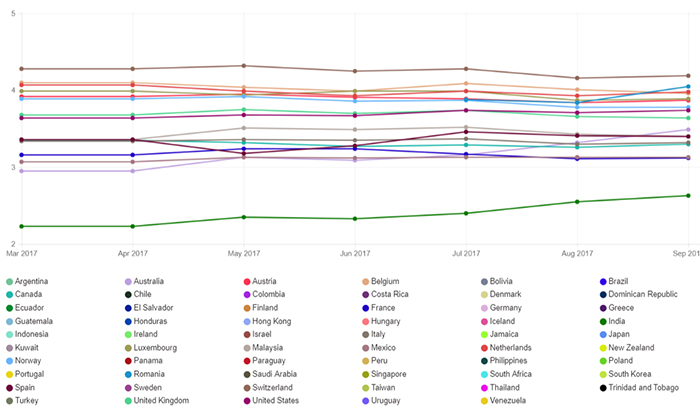Netflix - Not as fast (or slow) as you think
Par Sedai, 18 octobre 2017

In the US we like to think we’re at the top of the technological heap, but that’s not the case according to a new streaming report released by Netflix. The Netflix ISP speed index creates an average of Netflix download streaming speeds based on information from a cross-section of a nation’s ISP providers. The report further drills down to rank the top 10 ISPs within a country. The September report puts 11 countries ahead of the US, and France - sorry but you’re in 39th place.
This is data that changes monthly but there are definite trends over time. Switzerland always ranks first with an average download speed over 4 megabytes per second (mbps). The Netherlands and Belgium also hover around 3.9mbps or higher, while Austria, Sweden, and Luxembourg are neck in neck around 3.8. The US is still comparatively blazing fast, at 3.74 in September while France came in at 3.12. The lowest ranked countries like Venezuela and Honduras rank under 2mbps.
 The royal blue is France. Fuchsia (about midway down) is the US
The royal blue is France. Fuchsia (about midway down) is the US
We’re clearly talking about fractions of time here, especially among the top-ranked nations, differences most of us will never notice. Except that we do notice every time our stream buffers and we have to watch a spinning circle, wondering if we’ll get to see the end of our show. As consumers we’re incredibly attached to our entertainment and every time that happens we curse the internet gods, but somewhere in the back of our mind we’re probably also cursing Netflix just a bit. The rankings are the company’s way of deflecting our attention back to our internet service provider, saying “It’s not us, it’s them.”
This is all corporate mumbo jumbo though so last year Netflix also launched a consumer facing website to encourage viewers to test their local streaming speed for themselves. Fast.com isn’t a new concept – it works similarly to a number of other measurement sites like speedtest.net where users can test their local, current speed capabilities. Those are numbers that can fluctuate a lot throughout the day depending on how many people are online and what they’re doing. A Friday night when your entire neighborhood is streaming video is bound to return a lower speed rating than say, 2am on a Tuesday.
Netflix has had to figure out a way to turn focus back on ISPs ever since they faced criticism for slowing down transmission speeds over wireless networks; their excuse being they didn’t want people going over their data limits unknowingly. That may make smart business sense, since overage charges might lead to people cancelling their Netflix account, but as a rule we don’t like corporations interfering to make those decisions for us.

That mess followed a kerfuffle back in 2014 when ISPs, tired of shouldering all the cost for Netflix’s boost in streaming quality and number of shows, allowed the increased traffic just to bog down streams. That forced Netflix to purchase what amounts to dedicated lines to stream their content, a much better deal for ISPs.
So the next time you’re faced with a spinning circle in the middle of your favorite show head on over to Fast.com and see how fast your ISP is pushing data through. Then get on Twitter and yell at them, not Netflix.

Written by Sedai (Karen Youblonski Weazey)
Photos: Copyright Netflix

